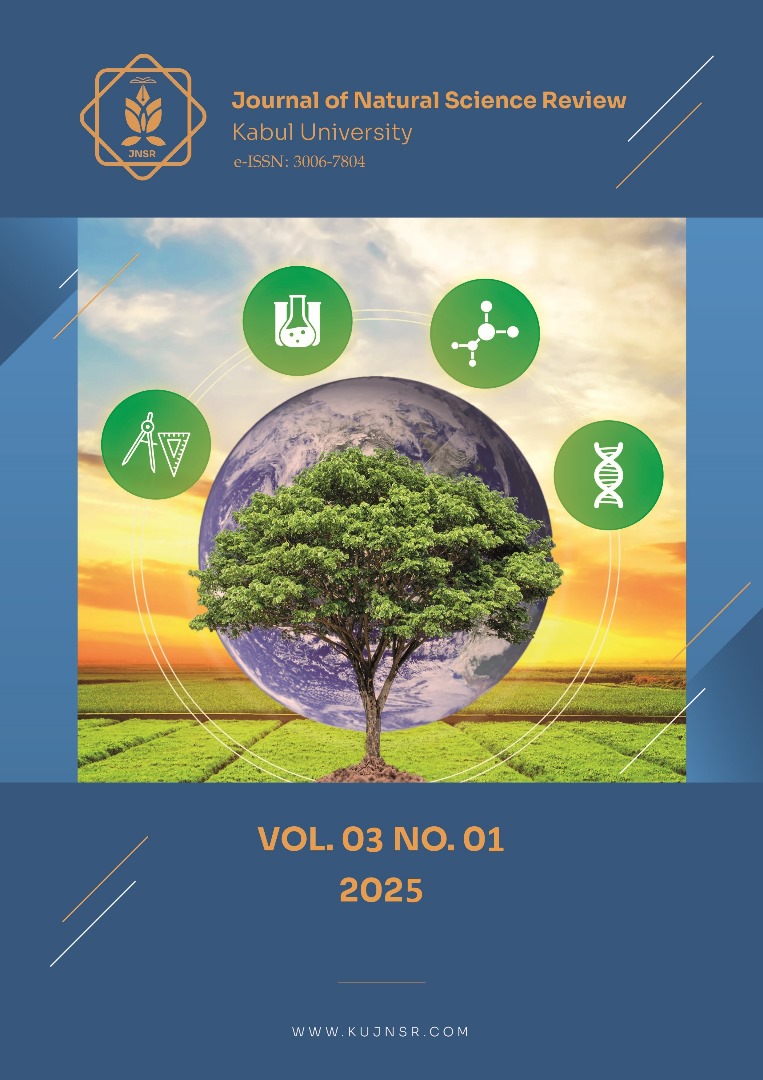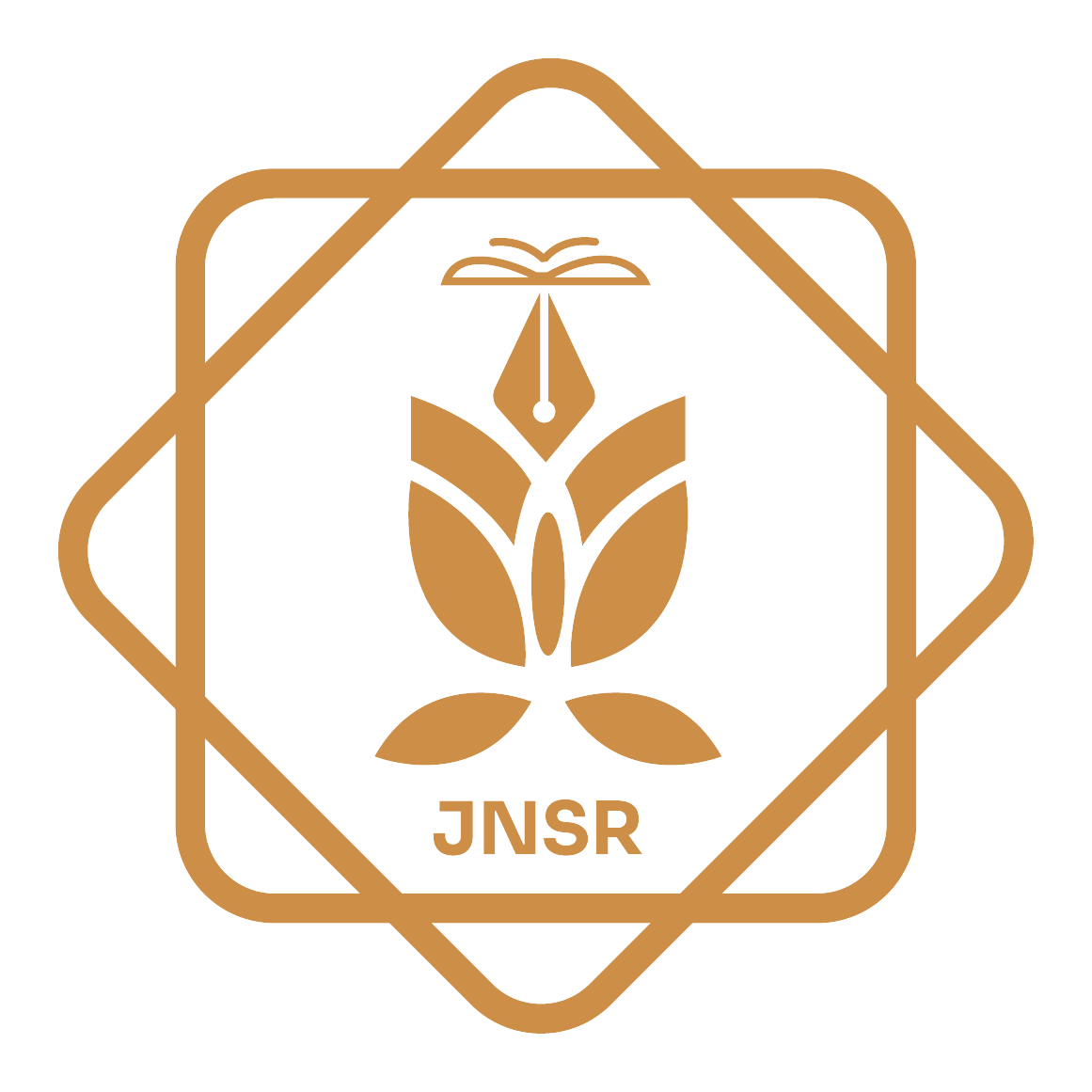Evaluation of the Efficacy of Chemical and Non-chemical Insecticides Against Onion Thrips in Field Conditions
DOI:
https://doi.org/10.62810/jnsr.v3i1.131Keywords:
intercropping, Thrips Tabaci, Chemical Insecticides, Botanical Insecticide, Attractive PlantAbstract
Onion thrips pose a significant threat to onion crops worldwide through their feeding habits, which can lead to visible damage and potential yield loss. This research aimed to investigate the effects of chemical and non-chemical insecticides on the management of onion thrips. This experimental study was conducted at the Faculty of Agriculture, Kabul University, to evaluate the efficacy of different chemical insecticides, a botanical insecticide, attractive plant, and intercropping for the management of onion thrips (Thrips tabaci) (Thysanoptera; Thripidae) on onion crops in 2023. Seven treatments were applied with three replications in a randomized complete block design. The first data collection occurred on July 12, 24 hours before the application of insecticides. Subsequent data were recorded 24 hours, 72 hours, and 7 days after each spray application. Three chemical insecticides were tested: carbaryl (Sevin® 85% WP) at a rate of 650 g/hectare, cyhalothrin (2.5% EC) at a rate of 550 ml/hectare, and cypermethrin (10% EC) at a rate of 400 ml/hectare. Additionally, a botanical insecticide derived from Melia azedarach (water extract of seeds) was applied at a rate of 12 L/hectare. After three applications, carbaryl showed significant efficacy compared to the other two chemical insecticides, while the botanical insecticide did not yield significant results. Attractive plants and intercropping demonstrated significant results when the leaves of the onions began to harden.
Downloads
References
Asghar, M., Baig, M. M. Q., Afzal, M. & Faisal, N. (2018). Evaluation of different insecticides for the management of onion thrips (Thrips tabaci Lindeman, 1889) (Thysanoptera, Thripidae) on onion (Allium cepa L.) crops. Journal of Entomology, 87: 167-176. https://doi.org/1080/0021213X.2018.1484423 DOI: https://doi.org/10.2478/pjen-2018-0012
Azazy, A., Abdelall, M. F. M., El-Sappagh, I. A., & Khalil, A. E. H. (2018). Biological control of the onion thrips, Thrips tabaci Lindeman (Thysanoptera: Thripidae) in open field using Egyption entomopathogenic nematode isolates. Egyptian journal of biological pest control, 28: 1-6. https://doi.org/10.1016/j.ejbc.2018.03.001 DOI: https://doi.org/10.1186/s41938-017-0025-9
Brunner, P. C., Chatzivassiliou, E. K., Katis, N. I., & Frey, J. E. (2004). Host- associated genetic differentiation in Thrips tabaci (Insecta; Thysanoptera), as determined from mt DNA sequence data. Nature publishing group, 93: 364-470. https://doi.org/10.1038/sj.hdy.6800512 DOI: https://doi.org/10.1038/sj.hdy.6800512
Capenira, J. L., (2001). Hand books of vegetable pests. Academic press. Pp 541.
Din, N., Ashraf, M., & Hussain, S. 2016. Effect of different non-chemical and chemical measures against onion thrips. Journal of Entomology and Zoology Studies, 5: 10-12. 10.22271/chemi.2016.v4.i10.760
Duchovskiene, L. (2006). The abundance and population dynamics of onion thrips (thrips tabaci Lind) in leek under the field conditions. Journal of Agronomy Research, 4: 163-166. 10.15159/AR.06.016
El-Naggar, J. B., & El-Hoda, N. Z. (2013). Field evaluation of imidacloprid and thiamethoxam against sucking insects and their side effects on soil fauna. Journal of Plant Protection Reseach, 53: 375-387. DOI: https://doi.org/10.2478/jppr-2013-0056
Fernandes, F. L., & Fernandes, M. E. S. (2015). Flight movement and spatial distribution of immunomarked thrips in onion, potato, and tomato. Brasilia, 50: 399-406. 10.1590/S0100-204X2015000500007 DOI: https://doi.org/10.1590/S0100-204X2015000500007
Farmanullah, F., Mulk M., Farid A., Saeed M. Q., & Sattar S. (2010). Population dynamics and chemical control of onion thrips (Thrips tabaci Lindeman). Pakistan Journal of Zoology, 42: 401-402.
Gachu, S. M., Muthomi J. W., Narla R. D., Nderitu J. H., Olubayo F. M., & Wagacha J. M.(2012). Management of thrips (Thrips tabaci) in bulb onion by use of vegetable intercrops. International Journal of Agriculture Science, 2: 39-43. 10.17582/journal.pjz/2010.42.4.401.406
Gill, H. K., Garg H. Gill A.K., Kaufman G.J.L., & Nault B. A. (2015). Onion thrips (Thysanotera: Thtipidae) Biology, Ecology and management in onion production systems. Journal of International Pest management, 6:1-9. 10.1093/jipm/pmv006 DOI: https://doi.org/10.1093/jipm/pmv006
Gholami, Z., Sadeghi, A., Garjan, A. S., Rafi, J. N., & Gholami, F. (2015). Susceptibility of western flower thrips Frankliniella occidentalis (Thysanoptera: Thripidae) to some synthetic and botanical insecticedes under laboratory conditions. Journal of Crop Protion, 4: 627-632. 10.22067/jcp.v4i4.48043
Jacobson, A., Nault, B. A., Vargo, E. L., & Kennedy, G. G. (2016). Restricted gene flow among lineages of thrips tabaci supports genetic divergence among cryptic species groups. Journal of plant protection research, 12: 67-75. 10.1515/jppr-2016-0042 DOI: https://doi.org/10.1371/journal.pone.0163882
Khaliq, A., Abas K. A., Afzal M., Tahir H. M. Raza A. M., & Khan A.M. (2014). Field evaluation of selected botanicals and commercial synthetic insecticides against Thtips tabaci Lindeman (Thysanotera: Thripidae) populations and predators in onion field plots. Journal of Crop Protection, 62: 1-10. 10.22067/jcp.v3i2.48042 DOI: https://doi.org/10.1016/j.cropro.2014.03.019
Khan, A. B., Panhwar, W. A., Mehmood, S. A., Gilal, A. A., Ahmed, S., & F.Ullah, H. (2017). Population of Thrips tabaci Lindeman, 1889 in onion crop from district Mansehra, Khyber Pakhtunkhwa, Pakistan. Journal of Entomology and Zoology studies, 5: 502-505. 10.22271/chemi.2017.v5.i4.2100
Kaur, S., Kular, J. S., & Chandi, R. S. (2017). Effect of temperature on growth and development of Thrips tabaci Lindeman in BT cotton. International journal of Microbiology, 6: 2553-2560. 10.20546/ijcmas.2017.605.287 DOI: https://doi.org/10.20546/ijcmas.2017.605.287
Loomans, A. (2003). Parasitoids as biological control agents of Thrips pests. ISBN: 90-5808-884-7 Pp 5-9. 10.1007/978-94-010-0108-4_2
Malkeshi, S. H. (2005). Survey of reproduction methods and mass rearing of the minute pirate bug Orius spp. (Hem: Anthocoridae) and application of them in order to control of thrips on and ornamental plants in the integrated pests management (IPM). MSc Thises, Ferdowsi University, Mashhad, Iran. Pp87. (In Persain).
Nikolova, I., & Georgieva, N. (2013). Effect of botanical insecticides neemazal-t/s and pyrethrum applied alone and in combination with different organic products on Thrips tabaci population density. Acta Entomological Society of Serbica, 19: 1-12. 10.2298/AES1301001N
Pourian, H. R., Balou M. M., Alizadeh M., & Orosz S. (2009). Study on biology of onion thrips, Thrips tabaci Lindeman (Thyasanoptera: Thripidae) on cucumber (Var. Sultan) in laboratory conditions. Journal of plant Protection Research, 49: 390-393. https://doi.org/10.2478/v10045-009-0056-3 DOI: https://doi.org/10.2478/v10045-009-0061-x
Pathak, M. K., Pandey, M. K., Gupta, R. C., & Gupta, P. K. (2018). Evaluation of different insecticides against thrips in onion seed production. International journal of current microbiology and applied science, 7: 4204-4207. https://doi.org/10.20546/ijcmas.2018.710.491 DOI: https://doi.org/10.20546/ijcmas.2018.707.491
Sadozai, A., Zeb Q., Iqbal T., Anwar S., Badshah H., Ali A. Ahmad M., & Tahir M. (2009). Testing the efficacy of different insecticides against onion thrips in tarnab, Peshawar, Sarhad Journal of Agriculture, 25: 26-39. https://doi.org/10.17582/journal.sja/2009/25.1.26.39
Sedaratian, A., Fathipour, Y., Talebi, A. A., & Farahani, S. (2010). Population density and spatial distribution pattern of thrips tabaci (Thysanoptera: Thripidae) on different soybean varieties. Journal agriculture science and technology, 12: 275-288. https://doi.org/10.1007/BF03021014
Schwartz, H. F., Alston D., Alwang J., Bartolo A., Blunt T., Boateng C. O., Bunn B., & Cramer C. S. (2014). Onion thrips ipmPIPE: A Coocdinated effort to improve the management of onion thrips and Iris yellow spot virus for the U.S. Onion industry. Plant health progress, 15: 172-174. https://doi.org/10.1094/PHP-RS-14-0137
Shiberu, T., Negeri, M., & Selvaraj, T. (2013). Evaluation of some botanicals and entomopathogenic fungi for the control of onion thrips (Thrips tabaci L.) in West Showa, Ethiopia. Journal of pathology and Microbiology, 4: 1-7. https://doi.org/10.4172/2157-7471.1000210 DOI: https://doi.org/10.4172/2157-7471.1000161
SAS Institute, 2002. Proc User’s Manual, Version 9. 1th ed. SAS Institute, Cary, NC. & Scholthof, K. B. G., (2007). The disease triangle: pathogens, the environment and society. Natural reviews, Microbiology, 5: 152-156. DOI: https://doi.org/10.1038/nrmicro1596
Toda, S., & Murai, T. (2007). Phylogenetic analysis based on mitochondrial CO1 gene sequences in thrips tabaci Lindeman (Thysanoptera: Thripidae) in relation to reproductive forms and geographic distribution. Journal of applied entomology and zoology, 42: 309-316. https://doi.org/10.1303/jjaez.42.309 DOI: https://doi.org/10.1303/aez.2007.309
Wei Li, X., Fail J., Wang, P., Feng, Ji. N., & Shelton A. M. (2014). Arrhenotakous and Thelytokous Thrips tabaci (Thysanoptera: Thripdae) on onion and cabbage and its implications on evolution and pest management. Journal of economic entomology, 107: 1526-1527. https://doi.org/10.1603/EC14121 DOI: https://doi.org/10.1603/EC14070
Downloads
Published
How to Cite
Issue
Section
License
Copyright (c) 2025 Mohammad Hamed Osmankhil, Mohammad Hussain Falahzadah, Nasir Nazari

This work is licensed under a Creative Commons Attribution-NonCommercial 4.0 International License.



























